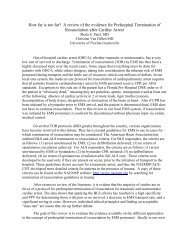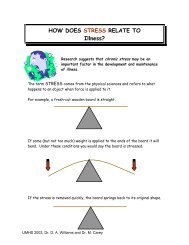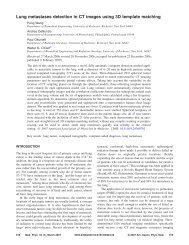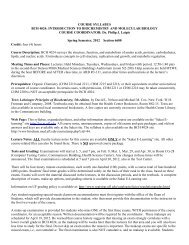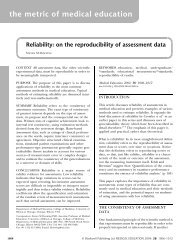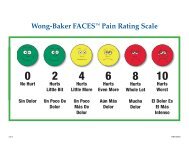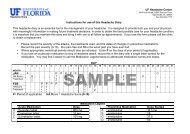imaging three-dimensional cardiac function - Walter G. O'Dell, PhD
imaging three-dimensional cardiac function - Walter G. O'Dell, PhD
imaging three-dimensional cardiac function - Walter G. O'Dell, PhD
You also want an ePaper? Increase the reach of your titles
YUMPU automatically turns print PDFs into web optimized ePapers that Google loves.
450 O’DELL MCCULLOCHAnnu. Rev. Biomed. Eng. 2000.2:431-456. Downloaded from arjournals.annualreviews.orgby UNIVERSITY OF ROCHESTER LIBRARY on 07/27/09. For personal use only.to deform by the laws of equilibrium. The error was computed between the finiteelement-predicted strain field and that measured with an MRI tagging grid over thatslice, and the constitutive law parameters were varied to achieve a minimal strain?error. This approach is analogous to that used by Guccione et al (105), who usedan axisymmetric 3-D finite-element model and transversely isotropic constitutivelaw to match 3-D strains measured at a single site, using radiopaque markers andcineradiography. When fully 3-D geometric representations are considered, includingfiber anatomy and material anisotropy, compressibility, and heterogeneity,this approach still involves substantial computational time. It is also conceivableto design an inverse approach based on matching measured surface tractions andstress equilibrium constraints (106), but this is highly susceptible to uncertaintiesin the strain field and all of the 3-D properties.Just as new modalities for <strong>imaging</strong> <strong>cardiac</strong> structure and <strong>function</strong> are aiding thecomputational estimation of myocardial stress and work, a priori knowledge ofmyocardial mechanics can be used to improve image segmentation and analysis.Duncan et al (107) described the general theory in a recent review, and it could beapplied directly to the finite element-based strain reconstruction methods for MRItagging data by Kraitchman & Young (77) and Young & Axel (89).Apart from improvement in <strong>imaging</strong> individual components of 3-D <strong>cardiac</strong> deformation,the assessment of multiple components during a single <strong>imaging</strong> session(and within a reasonable time frame) is likely to become of increasing interest.Very recently, WeDeen et al (108) have shown preliminary data for measuringboth myocardial strains and fiber direction in hearts from human volunteers andpatients using MRI phase-sensitive <strong>imaging</strong> and MR diffusion tensor <strong>imaging</strong>.Despite the capabilities available currently, the use of 3-D <strong>cardiac</strong> <strong>function</strong>alanalysis in the clinical setting remains limited. As outlined by the National Institutesof Health Cardiac MRI Work Group (109), the principal reasons for this includelong <strong>imaging</strong> times (compared with single-plane/projection <strong>imaging</strong>), timeconsumingand labor-intensive post-processing requirements (primarily in imagesegmentation), and lack of understanding of benefits by clinicians. To this list canbe added the difficulty in reducing and presenting the resulting voluminous andcomplex 3-D data sets into simple, informative parameters that can be readily usedby the clinician. The challenges are for commercial, academic, and governmentagencies to improve the efficiency of 3-D image acquisition, to bring near real-time3-D display of the processed image data into the examination room, and to performthe necessary clinical studies to demonstrate the capabilities of 3-D <strong>cardiac</strong><strong>function</strong>al <strong>imaging</strong>.ACKNOWLEDGMENTSThe authors acknowledge the many informative discussions and contributions fromPaul Friedman, Sabrina Au, and Elliot McVeigh, and funding support from theAHA and NIH grant HL41603. W. G. O. is supported by an American HeartAssociation Post-Doctoral Fellowship.



